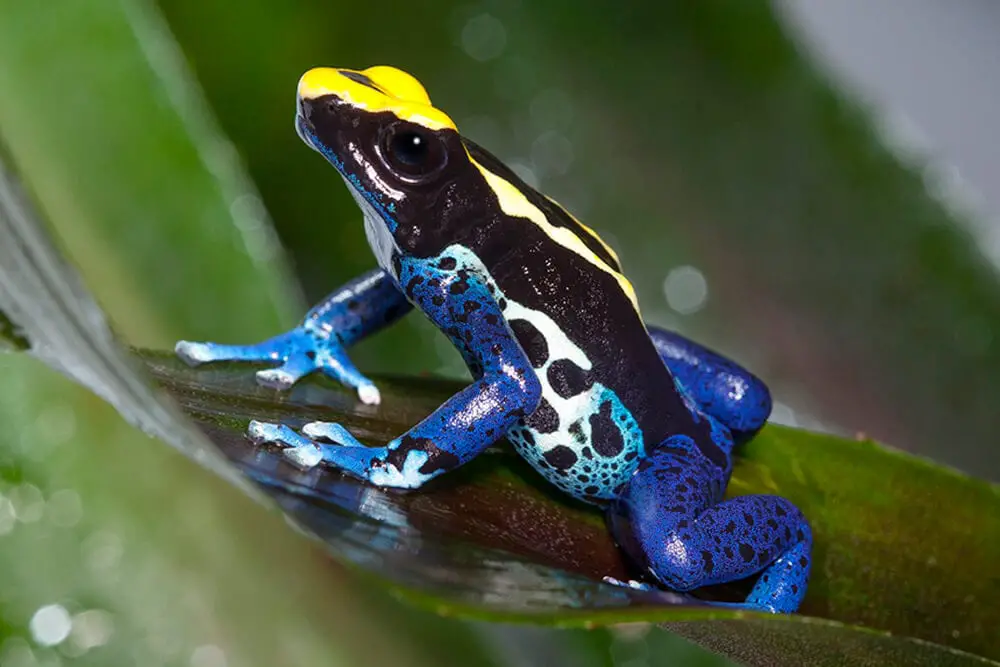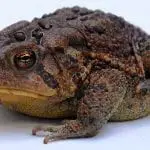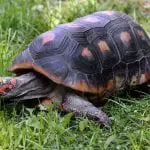Scientific Facts
| Common Name | Poison Frog, Poison Dart Frog, Dart-Poison Frog |
| Scientific Name | Dendrobatidae |
| Captive Lifespan | 5 to 8 Years |
| Size | 0.6 – 2 ½ inches |
| Mass | About 1 oz. |
| Habitat | Tropical, humid environments |
| Country of Origin | Tropical Central and South America |
Physical Description
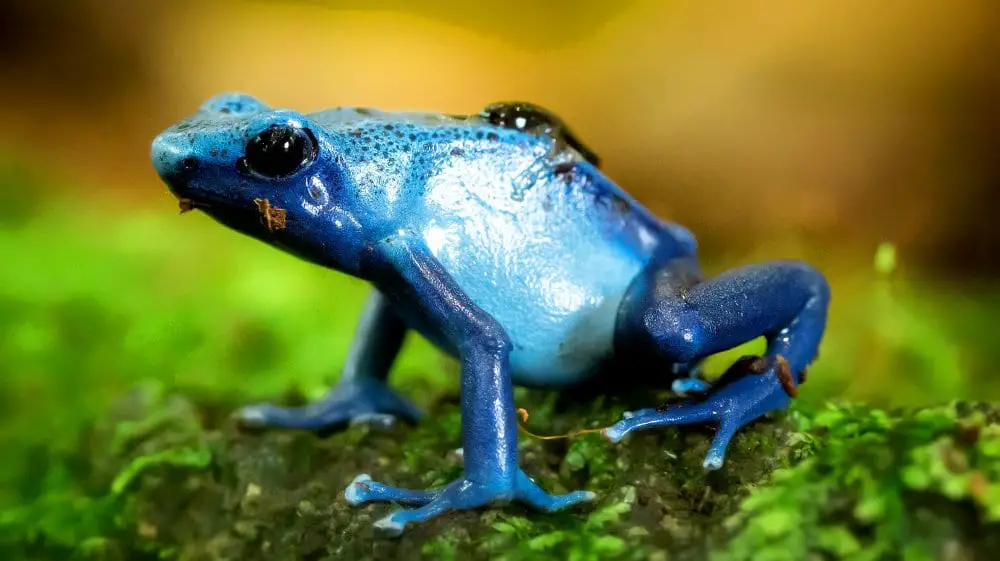
Poison frogs are extraordinarily bright, vivid colored species, most of which are known to display aposematic patterns, meaning that the brighter coloration indicates the higher levels of alkaloids, and hence, the higher toxicity. The incredible body coloration is used to warn potential predators in the wild.
To understand aposematism that is intertwined with poison frogs’ distinctive physical appearance, let’s look at a wonderful example: frogs belonging to the genus Dendrobates vs. frogs belonging to the genus Colostethus. Many Dendrobates frogs have very high levels of alkaloids, and in return, they exhibit very bright body coloration patterns. Meanwhile, Colostethus frogs are not toxic, and are only camouflaged-colored, as their cryptic coloration helps to protect them from predators by keeping them well-hidden in their natural habitat. It is important to note, though, that there are some species in the family Dendrobatidae which are also known to display cryptic colors and are only observed to possess low to none amounts of toxicity.
Most poison frogs are very small in size and can grow as tiny as 0.60 inches in length as adults. However, even though rarer, there are also a few species that are known to grow up to 2.4 inches in length.
Thanks to their unique, intense body coloration, ranging in dazzling hues of blue, yellow, red, gold, green, black, and copper, poison frogs automatically appear unpalatable to predators.
Types
Being a primary focus of phylogenetic studies, poison frogs are known to have undergone taxonomic changes quite frequently in the past, and this actually continues up-to-date, as we have so much more to learn about these incredible species.
The Dendrobatidae family was last revised taxonomically back in 2006. Currently, the family Dendrobatidae (part of the Dendrobatoidea superfamily) consists of approximately 170 species, and 13 genera.
The Adelphobates genus consists of 3 species. The Andinobates genus consists of 13 species. There are 31 species in the genus Ameerega, and 58 species in the genus Hyloxalus. There are 21 species of rocket frogs in the Colostethus genus vs. 5 species of poison dart frogs in the Dendrobates genus, such as the Dendrobates tinctorius “azureus” and the Dendrobates leucomelas.
The Epipedobates genus consists of 6 species of phantasmal poison frogs. With a total of 2 species in the Excidobates genus, and only 1 species in the Minyobates genus, the Silverstoneia genus consists of 3 species, and the Oophaga genus is made up by a total of 9 species.
6 species of Golden poison frogs are classified into the Phyllobates genus, while there are 21 species of thumbnail dart frogs classified into the Ranitomeya genus.
Throughout the course of history, differing coloration among poison frogs has to lead to the misidentification of single species as separate. For instance, it is believed that sexual selection has contributed to the differentiation among the populations of Oophaga pumilio in Bocas del Toro, while predation regimens are claimed to have influenced the polymorphism evolution in Oophaga granulifera.
Habitat & Lifespan
Poison dart frogs are found in the tropical rainforests of Brazil, Colombia, Costa Rica, Ecuador, Venezuela, Bolivia, Suriname, Peru, French Guiana, Nicaragua, Panama, and Guyana.
These frogs are endemic to tropical environments throughout South and Central America, and generally, their preferred habitat is humid, including both lowland forests and high-altitude shrubland. Some poison frogs are known to occupy freshwater marshes, swamps, and lakes.
Due to the ongoing deforestation, poison dart frogs have been progressively noticed to occupy seasonally wet pastureland, plantations, grassland, and rural gardens.
Poison frogs can be most commonly seen on the ground. However, it is also highly likely to spot Dendrobatids up in trees, up to 33ft. from the ground.
The average captive lifespan of poison dart frogs ranges from 4 and up to 8 years, even though occasional reports about captive poison dart frogs reaching over 20 years of age do also exist. In the wild, the lifespan of poison frogs is estimated to be between 3 and 15 years.
Behavior
Poison frogs are quite mildly-tempered species. One of the most curious traits of these amphibians’ behavior is none other but the male poison dart frogs’ deliberate parental care.
Some poison frog species are known to display quite unusual parenting habits, as they are known to carry the eggs, as well as the tadpoles, on their backs, thus, performing crucial transportation duties.
It is good to know that this type of “backpacking” parental behavior is not strictly exhibited by poison dart frogs, and in fact, it is not at all exclusive to amphibians.
However, male poison frogs have earned a solid reputation as some of the most amazing amphibian parents, since they demonstrate exceptional care for their young. Apart from carrying the eggs and tadpoles on their backs, some are also known to attend to the clutch exclusively.
Housing
1. Since most poison frogs are purchased as babies or juveniles, the caregiver is best to opt for an appropriately-sized, small, temporary enclosure, as this will ensure the well-being of the still immature poison frogs before they are finally ready to get transitioned into a larger, permanent enclosure later on.
2. At the early points of these amphibians’ development, a sweater box type of container will do great, and so will just about any translucent sided container of a similar size. For housing one and up to two baby/juvenile poison dart frogs, opt for a container of about 12 inches in length and 12 inches in width.
3. A sweater box (or any similar type of container) is highly recommended for baby/juvenile poison frogs because the caregiver will be able to maintain humidity levels nicely high at all times without much of a fuss. By simply opening the top every day or every other day, the immature poison frogs will get plenty of fresh air to thrive.
4. Another important benefit of opting for a sweater box container for housing small poison frogs is that the translucent sides will provide the amphibians a much-needed sense of security. If the caregiver is to go for a clear container, he/she should position the container right against a wall. Alternatively, at least two and up to three sides of the container have to be covered with paper to reduce any possible stress hitting the beautiful creatures.
5. Last but not least, by opting for a small container for housing baby/juvenile poison dart frogs, the young will be granted the opportunity to find their food easier, especially since they are known as quite timid hunters, as compared with adults that tend to be less timid in hunting their food. Ultimately, the major benefit of a small, simply set up, temporary enclosure for juvenile poison dart frogs can be summed down to concentrating food, thus, making food more available for the still immature amphibians to thrive.
6. When a poison dart frog is to grow larger, so must the size of the enclosure. Mind that large poison frogs are known to enjoy spacious enclosures, so both front-opening terraria, as well as standard glass fish tanks, can work excellent.
7. The secret key to success when housing a poison dart frog is to stay away from overcrowding the enclosure, and nonetheless, to avoid cohabitating different poison frogs together as a group, since some species are much more territorial than others, and this can spell disaster in group settings. Rather than adding any new frogs, keepers are strongly encouraged to keep the initial group stable.
8. For one and up to two mature poison dart frogs, caregivers should utilize a 10-gallon tank. For housing three large poison dart frogs, a 20-gallon tank should be utilized.
Substrate
1. Poison dart frogs can thrive on various types of substrate. For bioactive enclosures, organic soil mixes should be utilized. However, keeping in mind the rather wet conditions required by captive poison frogs, if the enclosure is not bioactive, then a nonorganic substrate is strongly recommended.
2. Nonorganic substrates make a better alternative to organic soil mixtures since organic ones tend to sour and/or rot very quickly. Apart from leading to a swampy smell within the enclosure, rotting/souring of organic substrates can start culturing fungus gnats, thus, causing potential health harm to poison frogs. One of the worst types of organic substrate for housing poison dart frogs is ground coconut husk, as it begins to rot within months.
3. Poison frogs caregivers are highly encouraged to opt for natural aquarium gravel, such as natural river pebbles, by layering 1/8 inch at the very bottom of the enclosure.
4. After diligently layering 1/8 inch natural aquarium substrate, add dried leaves and patches of moss, as well as several suitable hide spots (cork-bark ones work excellent). Last but not least, decorate with plants, so that not only the aesthetics of the terrarium will be enhanced, but the environment will mimic better the natural habitat of these amazing creatures to ensure their well-being.
Temperature & Lighting
1. As a rule of thumb, the lighting and temperature requirements of poison dart frogs raised in captivity are fairly easy to achieve and maintain success. In the wild, these creatures inhabit the forest floor, where temperatures are rather cooler, as compared to the average temperature range within the steamy, hot rainforests. Plus, lighting on the forest floor is also dim, and this is what caregivers need to simulate.
2. Keep the daytime temperatures within the 72 – 80 degrees Fahrenheit range. If temperatures exceed 84 – 85 degrees Fahrenheit, this will lead to the death of the captive poison frog within only a matter of a few hours. At night, temperatures can be allowed to drop down to about 60 – 65 degrees Fahrenheit (but not any lower!).
3. Whenever the temperature within the room where the poison dart frogs’ terrarium is placed is to get warmer, such as during the summer season, caregivers must remember to keep a close eye on the temperatures within the enclosure, too. Because of the lighting on the tank, the temperature within the terrarium can sometimes easily exceed the optimal rates, provided the room temperatures are to rise above the average, so monitoring and adjusting as needed is crucial.
4. Poison frogs do not have any special lighting requirements, as they only need as much light as to be able to see their food. For a 10- and up to 20-gallon tank, just about any suitable daylight reptile lamp will do the trick. In particular, caregivers want to look for a 20-watt fluorescent bulb in the daylight color spectrum.
5. Mind that brighter lighting can be beneficial to help live plants within the enclosure do better. Also, brighter lighting will certainly enhance the terrarium’s aesthetic appeal.
6. For brighter lighting, keepers are strongly recommended to opt for CFL light bulbs (“CFL” stands for “compact fluorescent lights”). Alternatively, T-5 fluorescent lights can make a wonderful option.
7. With CFLs and T-5s alike, suitable fixtures with reflectors that will help to properly maximize the light that gets into the enclosure should be utilized, too.
8. For a 20-gallon tank, caregivers need at least two 20-watt T-5 bulbs or a single 55-watt CFL bulb in the daylight color spectrum. Remember that you will need to switch to higher wattage for larger enclosures.
9. Not the least, LED lighting is considered extremely useful for taking the best care of poison dart frogs in captivity. The LED lighting is nonetheless beneficial to sustaining the live plants within the terrarium without high, unwanted energy and heat output.
10. If poison frogs’ caregivers are to opt for brighter lighting as described above, and not for a single 20-watt fluorescent bulb, then both miniature orchids and bromeliads can be sustained within the enclosure without much of a fuss.
11. Ultimately, if the keepers are to utilize high-output, bright lighting, then it is a must to combat the excess heat produced by these bulbs. For this purpose, cooling fans make a wonderful option.
12. At any cost, avoid incandescent bulb lighting. This type of lighting will overheat the enclosure at some point, possibly leading to lethal consequences for the poison frogs.
Diet
Scientists believe that the way poison frogs acquire their toxicity in the wild for the purpose of defending against predators is by the plant poisons they assimilate after ingesting insects found in the rainforests. The poison dart frog species that possess higher toxicity are considered to derive it from their diet rich in mites, ants, and termites.
However, other species of poison frogs that are known to have only low to no amounts of toxicity at all are known to feed on a significantly larger variety of prey, exhibiting cryptic coloration as a result of their far more varied diet.
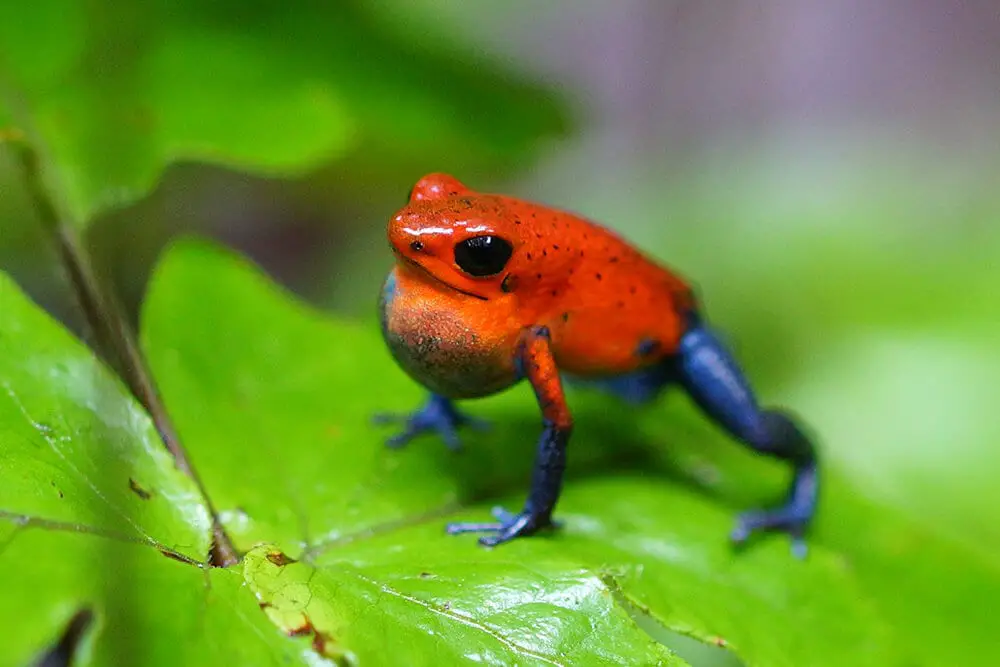
Eating Habits
1. Poison frogs are exclusively insectivores. Therefore, their feeding routine consists of only small live insects.
2. For captive poison frogs, caregivers can provide a variety of insects. The two most widely used types include crickets and flightless fruit flies, with flightless fruit flies best to be used as the primary food source for these unique amphibians.
3. In order for caregivers to culture flightless fruit flies, this practice should only require as little as a few minutes of work every couple of weeks or so. Since culturing flightless fruit flies is fairly easy, and with the needed supplies being rather inexpensive, it is highly recommended that poison frog keepers are to do their proper research and culture these insects as extremely useful and beneficial food items, especially with a mind to the health and well-being of poison dart frogs in the long run.
4. Crickets are also a wonderful food item for poison frogs raised in captivity. However, there are certain challenges related to feeding crickets as the primary source of food for Dendrobatidae, as it is often the case that most of the pet stores do not offer crickets that are small enough in size. Another challenge is that crickets grow very quickly in a fairly short period of time, therefore, becoming too large to feed to poison dart frogs.
5. All insects that are to be fed to captive poison frogs must be dusted with a good-quality vitamin and calcium supplement.
6. As poison frogs will eat only appropriately-sized food items, they also tend to eat lots of these items. For properly feeding juveniles, caregivers should provide approximately 20 – 30 fruit flies per each feeding routine. For young adult poison dart frogs, this amount should be doubled up to 50 – 75 fruit flies per feeding.
7. Feed poison dart frogs four and up to five days every week.
8. At some point in taking care of a poison dart frog, the keeper will be able to notice that the amphibian is doing fairly well with its feeding routine. Once the feeding routine has been well-established, the frogs may get to appear visibly full, with fat bellies. When the caregiver is to notice the fat belly of an adult poison frog, this means that the animal can go without food for several days without any problems.
Sleeping Habits
Poison frogs are diurnal creatures. They are active during the day, and a peaceful retreat to rest during the night.
Water & Humidity
1. Just like all other frogs, poison frogs do not drink water directly from a water bowl/container or from various water sources on the ground when it comes to poison dart frogs in the wild. The way these creatures keep themselves well-hydrated is by absorbing moisture via their skin, through their surroundings, such as from rain or simply from tiny droplets of water on leaves.
2. Since captive poison dart frogs are to absorb water from both the humidity present in the air of the enclosure, as well as from various small water pockets and surfaces in the tank, high humidity is key.
3. The humidity levels within the poison frogs’ enclosure should be maintained within the 100% – 80% range, and not any lower. As a rule of thumb, though, it is best to keep humidity within the 100% range. Even though poison frogs can tolerate humidity levels slightly lower than 100% (but then again, not less than 80%), they really dislike drier environments, and will simply prefer to hide if the humidity is not as high as to match their preferences.
4. Mind that poison frogs do not really enjoy ventilation (especially if it is dry household air to ventilate the enclosure), and actually, they don’t really need much ventilation at all. Of course, this is not to say to leave them to suffocate. However, live plants, as well as regularly opening the top of the enclosure for feeding the frogs, will provide enough ventilation as to allow for stagnant air to be exchanged, and for proper levels of oxygen to penetrate the tank, without the need to utilize any special equipment.
5. Keepers do not need to provide a water bowl for poison frogs. Remember, it is high humidity that keeps these animals healthy, happy, hydrated, and active.
6. Even though captive poison frogs do not require a water bowl, some caregivers choose to provide one anyway. In such cases, it is imperative to always treat the water with a chlorine-removing product. At any cost, make sure to change the water frequently, or else, bacterial infections can quickly develop due to standing, dirty water within the enclosure.
Development and Reproduction
Adult poison frogs are known to lay their eggs in highly humid, well-moist spots, such as among exposed roots or on leaves on the forest floor, among others.
As soon as the eggs hatch, adult poison frogs will “backpack” or “piggyback” the tadpoles, only one at a time. The adults will transport the tadpoles to a suitable water body, which can be a water pool or simply water that has been collected in the very throats of various live plants, such as bromeliads.
Tadpoles are to remain in the water until the metamorphose stage has been fully accomplished. As they metamorphose, tadpoles feed by the unfertilized eggs that the mother lays at strict intervals.
The eggs of poison frogs are fertilized externally. In a similar manner as most fish, once a female poison frog is to lay a cluster of eggs, the male is to then fertilize them.
Generally, it is female poison dart frogs to make the mating choice. The way female poison frogs choose a male to mate with is based on the males’ dorsal coloration, territory, and the calling perch location.
Because of this, males are rather territorial, they are brighter colored than the females, and nonetheless, they are aggressive toward other male poison frogs, all for the purpose of attracting females.

How to Breed
Most poison dart frogs reach sexual maturity at about 12 months of age. However, some species reach sexual maturity later, so in case one is to attempt breeding, proper research is a must.
To increase the chances that the pair will breed:
1. Increase the amount of misting to 2 – 5 times daily to simulate the wet season.
2. Increase the variety of feeders.
3. Increase the feeding amount.
4. Ensure proper vitamin supplementation and nutrition.
5. Offer fly fruit larvae, termites, flour beetle larvae as suitable fatty food sources.
6. You can try separating the pair a few weeks prior to breeding, and then re-introduce them to stimulate mating. Also, with some types of poison dart frogs, another male can be added to spice things up and stimulate breeding.
7. Always have a supply of fresh water within the enclosure.
Handling
No matter how tempting it may seem to hold the vividly colored, small-sized poison frog pet in your hands, it is best to treat these stunning amphibians as hands-off creatures, and that’s because their skin is so sensitive and delicate, that any excess handling can easily lead to harm.
Whenever the keeper needs to move the poison dart frog, such as when it comes to transportation or enclosure maintenance purposes, handling is acceptable, but make sure it is as brief as possible.
Remember, handling a poison dart frog for anything more than a moment or two can cause serious harm to the amphibian, resulting in dangerous health issues.
If the caregiver needs to catch a poison dart frog, this should happen very quickly, with a confident move and a firm grip (but not too tight as to threaten the creature’s well-being). Loosely grasp the frog and speedily place it into a suitable holding container.
How to Treat and Prevent Possible Health Issues
Even though poison dart frogs are easy-to-take-care-of, due to their straightforward care requirements that are effortless to follow and maintain correctly, even by beginners, caregivers must remember that these amphibians are also very delicate creatures.
Lighting, temperature, humidity, and feeding requirements must be followed religiously, or else, these incredible creatures can quickly die off, sometimes within only a couple of hours, for seemingly no reason.
Do not touch, pet, or handle these animals for your personal joy and entertainment. Respect them, and give them the proper care and attitude they require in order to thrive.
If culturing flightless fruit flies, be especially careful about the cultures potentially getting crawled with nasty, stubborn mites.
Possible Dangers to Humans
Captive-bred poison dart frogs have no poison in their skin. However, it remains a must that the caregiver is to wash his/her hands with soapy, hot water every time after handling a poison frog, which is the golden rule with just about any amphibian or reptile.
The caregiver should avoid touching his/her mouth prior to thoroughly washing hands, like all reptiles and amphibians alike, although, in rare cases, may possibly transfer Salmonella bacteria to humans.
Availability: How to Get a Poison Frog?
Most poison frog vendors offer babies and juveniles. While babies, as well as juvenile poison dart frogs, are absolutely adorable, it is important to mind that they are much more fragile than mature frogs, and nonetheless, they are much more difficult to be well-established, especially when it comes to beginner caregivers. Because of this, it is strongly recommended to avoid purchasing baby poison dart frogs of less than six weeks of age, as well as less than ½ inch in length.
Your safest bet is to get a poison frog of between 3 – 5 months of age, typically about 1 – 1 1/3 inch in length. Larger juveniles will be much more well-established, and as a result, keepers will stand a significantly higher chance to ensure the amphibian’s well-being and longevity.
Only purchase poison frogs from reputable, trustworthy vendors, such as breeders, and/or from reliable pet stores and various reptile shows, as to get a guarantee that the amphibian is captive-bred, and not wild-caught. Currently, despite the ongoing success of breeding poison frogs in captivity, illegal trade is still flourishing, posing ugly threats to the vulnerable populations of poison dart frogs in the wild.
As the illegal harvest of poison dart frogs continues, and especially with many of them being caught in the same area, this greatly diminishes genetic variety in the wild, weakening the populations to the very point of extinction. As we cannot afford to contribute to these amazing creatures disappearing from the wild forever, amphibian enthusiasts have the power and responsibility to make an informed choice when purchasing a poison frog, as not to stimulate illegal pet trade.
Plus, wild-caught poison frogs can get the caregiver running into a variety of potential problems. Trustworthy vendors will be able to provide follow-up support.
Fun Facts
1. Some poison frogs are known to carry epibatidine, which is a morphine-like compound that can send messages between nerve cells, with a single poison frog’s worth of epibatidine being enough to kill an adult water buffalo.
2. The smallest poison frog species are referred to as thumbnail frogs. Yes, they can perfectly fit on a person’s thumbnail. However, thumbnail frogs are somewhat trickier to keep, so caregivers should better wait until they become better experienced with “ordinary” poison frogs before they choose to purchase some of the tiniest poison dart frog species.
3. One of the possible explanations of the development of aposematism in poison dart frogs is suggested to be prey mobility. Since some of the poison frogs in the wild have shifted from nocturnal to diurnal activity, it is believed that they were provided another reason to develop aposematic coloration. This further suggests that aposematism is an incredible way for organisms to get access to a wider range of resources, as well as to increase reproductive success, indicating that aposematism is a far more complicated and enchanting phenomenon than merely serving as a defensive mechanism against potential predators.
4. The most poisonous of poison dart frogs is Phyllobates terribilis, aka the golden poison frog, having enough toxin to kill about 10 000 mice, or about 10 – 20 men. However, most other poison frogs in the wild are really not toxic enough to pose serious damage to large animals or humans, even though they are brightly colored and toxic enough to discourage predation successfully.
5. For centuries, the indigenous Emberá people have used the powerful poison of these frogs for tipping blowgun darts for hunting, and hence the term “dart” in the common name of the genus.
6. In 2013, deep in the Peruvian Amazon, Shirley Jennifer Serano Rojas, who is a herpetologist, discovered a new poison frog species – the Ameerega Shihuemoy – found exclusively in an area of rainforest regeneration subjected to only selective logging. “Shihuemoy” is actually the native Harakmbut name for poison dart frog.
7. It is not uncommon to observe poison frogs clutching each other, as if seemingly in the process of copulation. However, clutching is not copulation, but instead, it is a demonstration of territorial wrestling, with both female, as well as male poison dart frogs, commonly engaging in such territorial disputes. Male poison frogs are known to fight for getting access to the most prominent roosts where they can broadcast their mating call to attract females, while females are known to fight over the most desirable nest sites.
How to Take Care of a Poison Frog
1. Even though it is not recommended to opt for baby and small juvenile poison dart frogs, it is important to note that if this is the case, then a different substrate is required than when it comes to adults. Caregivers want to ensure a well-moist substrate, such as sphagnum moss (ideally, long-fiber), topped with only a few leaves that will serve as hiding spots.
2. As a rule of thumb, a suitable enclosure for poison frogs should be large enough based on the size of the frog. Always wait until the poison frog has become large enough before transferring it into a larger tank. Also, it is best to keep poison dart frogs in temporary setups for about six weeks after being acquired, so that they can get well-accustomed to the keeper’s feeding and care, and to demonstrate good health and normal growth before being transferred to larger enclosures, as if done earlier than needed, this can cause unwanted stress.
3. It is strongly recommended to set up the poison frogs’ tank in advance, as to get it running for a few days, so that the temperature and humidity rates can be carefully monitored, and adjusted if needed, prior to putting the frogs inside.
4. Since high humidity is a crucially important factor to keep captive poison frogs healthy and happy, always use thermo-hygrometers, and never guess!
5. If you notice that your poison frog is hiding, cut back on the ventilation and closely check-up humidity levels, raising them on the higher side of the optimal rates.
FAQ Section
Are Poison Frogs Endangered?
Yes, many species of poison dart frogs are endangered because of habitat loss caused by human encroaching, as well as because of the illegal pet trade and chytrid disease. Some poison frogs are listed as threatened, while others are listed as endangered with extinction.
Can You Own a Poison Dart Frog as a Pet?
Yes, poison dart frogs can be kept as pets. When raised in captivity, poison frogs actually become non-poisonous, which is widely believed to be due to the different diet for captive poison dart frogs, as compared to the diet of these amphibians in the wild.
Can You Keep Different Poison Frogs Together?
Technically, it is possible to keep some different poison frog species together; however, this rule is not set in stone, as some poison dart frogs, such as Dendrobates tinctorius “Cobalt” and Dendrobates tinctorius “Azureus,” among others, should NOT be grouped, housed, or otherwise mixed together. Some poison dart frogs do well in individual sexed couples, while others can be kept in groups of 3 or more of the same species. At any cost, hybridizing MUST be avoided.
Is it Easy to Take Care of a Poison Frog?
Yes, as long as one is responsible and diligent enough, it is easy to take care of a poison dart frog, even for beginners. These frogs require only low maintenance, as compared with other amphibians one can keep as pets. Once a proper enclosure is set up, with lighting, humidity, and feeding being religiously followed, poison dart frogs can quickly become the focal point of just about any room, holding a very special place in the caregiver’s heart.
What Is the Largest Poison Frog?
The largest poison dart frog is Phyllobates terribilis, the golden poison frog. Also commonly referred to as the golden frog or golden dart frog, the largest poison dart frog is endemic to Colombia’s Pacific Coast.

